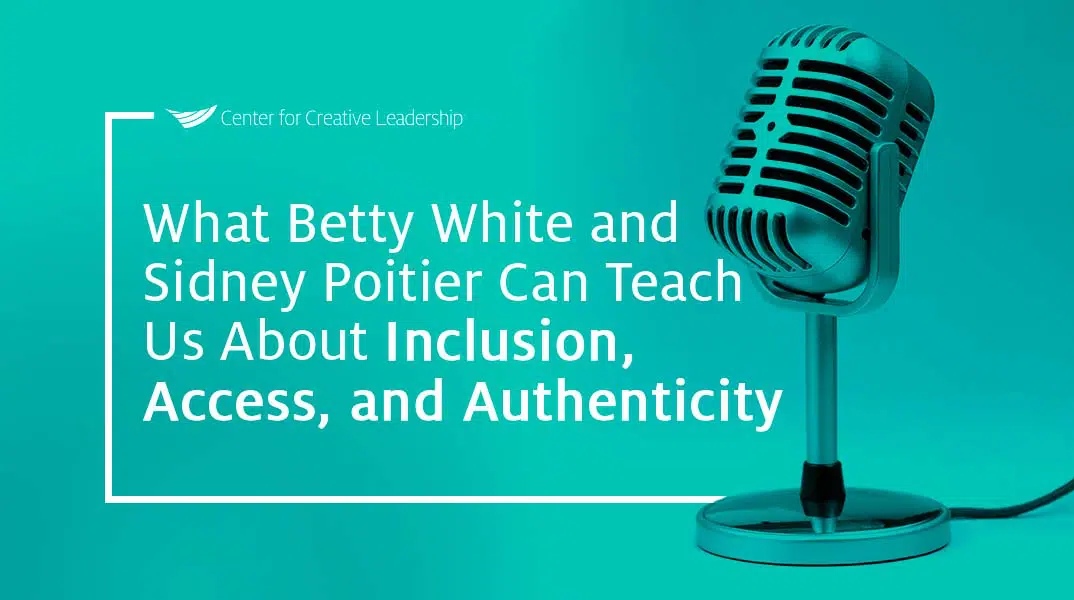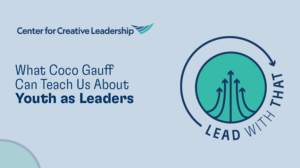- PODCAST
Lead With That: What Betty White and Sidney Poitier Can Teach Us About Inclusion, Access, and Authenticity

In this episode of Lead With That, Ren and Allison explore what we can learn from the barrier-breaking legacies of Betty White and Sidney Poitier.
On December 31st, 2021 actor, comedian, animal rights activist, and author Betty White died just weeks before she would have celebrated her 100th birthday on Jan. 17, 2022. Just a week later, the first black man to win an Oscar, an actor that paved the way for underrepresented actors around the globe, Sidney Poitier died at the age of 94, on January 7th, 2022.
Specifically, we’ll explore the things we can learn from Sidney and Betty about inclusion, access, authenticity and what leaders can learn from their experiences.
We’ll also ask you to consider why we’re talking about the importance of authenticity, and what systemic biases exist that you have the power to help dismantle both internally and externally. Join us as we challenge you to make Betty and Sidney’s examples catalysts for inclusion and access on your teams and at your organization.
Listen now or read the full transcript below.
Listen to the Podcast
In this episode, Ren and Allison explore what we can learn from the barrier-breaking legacies of Betty White and Sidney Poitier.
Interview Transcript
INTRO:
Welcome back to CCL’s podcast Lead With That. We talk current events and pop culture, we look at where leadership is happening, and what’s happening with leadership.
Ren Washington:
And they said 2022 would be easier, Allison.
Allison Barr:
They did.
Ren Washington:
I know.
Allison Barr:
Liars.
Ren Washington:
Unfortunately, on December 31st, 2021, actor, comedian, animal rights activist, and author, Betty White died just weeks before she would’ve celebrated her hundredth birthday on January 17th, 2022. And not but a week later, the first black man to win an Oscar as a leading man, an actor that paved the way for underrepresented actors around the globe, Sidney Poitier died at the age of 94 on January 7th.
And while their loss is sad, we’re going to spend today celebrating their legacy a bit. Kindness and consideration of somebody besides yourself keeps you feeling young. Betty said that. And today we’ll be looking at the things we can learn from Sidney and Betty, both about inclusion, about access and what leaders can learn from their experiences to make a difference back home. To make people feel included, to help them feel belonging. And ultimately, having that inclusion serve as a power booster for our teams and our organizational effectiveness.
Ren Washington:
Welcome back, everybody. I’m Ren Washington. And as usual, I’m joined with Allison Barr. Allison, have you ever watched Golden Girls?
Allison Barr:
Oh, have I? Yes. Me and my college roommate, I think it was my second year of college, we used to watch reruns of the Golden Girls frequently. Yes. How about you?
Ren Washington:
A little bit. I think my parents may have watched it. Or it was very popular and I was on the tail end. I think my favorite story about Golden Girls, just Betty White adjacent, is that the mother of whatever, one of the three women, she was actually younger than the actress who played her daughter. And so, that was all done by makeup and prosthetics. And she felt a certain kind of way about that.
Ren Washington:
That was my limited exposure to Betty White in the early days. But then she had her Betty renaissance. And she became very popular and really prevalent on comedy shows and roasts. And so, that’s when my focus drifted back to her.
Allison Barr:
Yeah. I was thinking about Gen Z. And I was thinking like, “Does Gen Z know Betty White, aside from her being on so many memes?”
Ren Washington:
That’s funny.
Allison Barr:
Betty White is a meme for everything. And so, yeah, I think a lot of us probably know her from the Golden Girls and maybe even some of us know her from her own talk show. But yeah, I love reading about her resurrection, if you will. Post-golden Girls, she was involved in some really fun and hilarious sketches.
Ren Washington:
Yeah. Well it makes me think too, generationally about Sidney Poitier and how my other problem was, have you ever seen Raisin in the Sun?
Allison Barr:
No.
Ren Washington:
A Raisin in the Sun? No? How about a Guess Who’s Coming to Dinner?
Allison Barr:
No, I will just let you know that I hadn’t seen, I don’t believe any of his earlier movies. However, my mom was and still is, of course, a huge fan. And had encouraged me to watch both of those that you just referenced. I should get on that.
Ren Washington:
Well, I mean, I don’t know if you need to. There was a remake of Guess Who’s Coming to Dinner with Ashton Kutcher and Bernie Mac. You can check out a modern retelling of it. But what I think is interesting and maybe too as leaders, you listening and thinking about longevity of message and legacy, Sidney Poitier was active in the civil rights. I mean, honestly, I don’t know a whole bunch of his work.
And too, and Betty, they’re from different generations for me. Yet, they have this impact, this long-term withstanding, sustaining kind of impact. And as we talk a little bit about them today, I’m interested to find some themes or trends about how they would be able to be so impactful, how they’re able to show up in people’s lives. And see too, the difference that they made for people who were in their industry and people outside of their industry.
Allison Barr:
Yeah. And they both were in different ways. Betty, from what I read and listened to in preparation for this podcast, Betty White was maybe more outspoken in her advocacy for women’s right, civil rights. Advocacy for the LGBTQ+ community. Of course, animal rights as well.
And what I read and heard about Sidney was his life story … I can’t even find the words if I’m being honest. But his story’s really of perseverance and grace. And in the face of difficulty, in a time where the KKK visited his home. The environment that he grew up in is generally incredibly detrimental to people’s, their health, their wellbeing. Yet, somehow he stayed true to who he is, who he was and was able to persevere.
Ren Washington:
Yeah. I know we could do a whole other series on these historical icons. And I think it’s fair to call Betty and Sidney icons. These people who were these epitomizations of what it looked like to do it with grace and to fight through and persevere. And it is amazing what they were able to make it through.
And I think it’s really interesting and maybe too, as we start to talk today about how they were able to model behaviorally, this idea of, “I’m here and I’m bringing you all with me. I’m opening the door and it’s not just for me, it’s going to be for all of us.” And you were just talking about Sidney’s upbringing. And I saw this awesome quote that he told Newsweek in the interview in the late 80s. And he was saying, “I made films when the only other black on the lot was the shoe shine boy.” As was the case at Metro, he said. “I was the lone guy in town.”
And I know Betty White was much the same way. I mean, a comedian, a woman coming up in the 50s in show business. I mean, that must not have been an inclusive space. And so, I’m really interested to start to hear and see those things that they said or did. And how that all starts to show up. And then maybe, shift our attention to what do we mean by access? What do we mean by inclusion? And then I have a question for you too about a word that we use around campus. But maybe first things first, just digging into those other things. What do you think?
Allison Barr:
Yeah, that sounds great. And when I think of Sidney’s upbringing. He’s born in the Bahamas in a relatively poor environment. Eventually moved to Florida and hadn’t experienced segregation to the extreme that was prevalent at that time in the United States. Right.
There’s a story that he told in an interview in NPR that he had got a job in delivering packages. And so, he went to deliver a package to a white woman’s home. And he knocked on the door. She opened it. This woman screamed at him and said, “You need to go to the back door.” And he said, “Well, I’m here and I have your package. Here’s your package.” And she slammed the door in his face. And so he didn’t really necessarily connect the dots. And he just left the package at her front door and left.
And later came to find out that this woman must have somehow reported him to the KKK. The KKK showed up at his house. Parents were terrified. It was a very, probably traumatizing experience. But what he said from that was that he just continued to do life as it was true to him. Which, as I understand, became a theme for him. Right.
Even in his acting, after he was the first black man to win an Oscar, somebody asked him, “You have a certain look about you. And how do you make that look in your roles?” And he said, “Well, I’m not acting, this is just who I am.” And I just, I don’t know. I found that to be really interesting. I have so many curiosities around that. Right. I am going to be who I am, regardless of what I’m in the face of.
Ren Washington:
Holding onto that authenticity, in the face of all that would be dangerous and treacherous about it, seems so unique. And maybe too, that’s as a leader, if you’re listening and thinking about impact and legacy and opening the door for others and holding it open, it’s maybe modeling that authenticity. Even when there’s a risk for it.
It was funny. We were talking on the pod, but I think it too, in my house, we were talking about Elizabeth Holmes and Theranos. If you haven’t heard about the Theranos story, Elizabeth Holmes, don’t worry. We’ll likely cover some of it one day on the podcast, but you got to check it out. But we, my wife and I were talking about this idea of a façade. And during this, it was pretty clear that Elizabeth Holmes had a pretty interesting facade on as she was this CEO of Theranos.
And when I think too about this idea of façade, my wife said, “Isn’t it crazy how she did all that?” And I thought, “Well, I mean, she went to some interesting lengths, but the idea of a mask or a façade, not crazy to me.” Because I think covering is a word that you might be familiar with in the equity, diversity inclusion space, where you have this idea where you might cover pieces of your identity or cover pieces of where you’re from.
And so, as a leader to be authentic, or as Sidney did, to be authentic and not cover. And not be what he was supposed to be. In the heat of the civil rights moment. It’s amazing how he was able to do that. And so I know, I think, man, what a lesson to model authenticity, if you want to create an environment where authenticity can thrive.
Allison Barr:
Yes. And Betty White was certainly the same. Now that we’re talking about it. She divorced her first husband in 1949.
And the reason she divorced him was because he wanted a stay at home wife. And that was not what she wanted for herself. We’re talking about 1949. We’re talking about a time where women faced major social pressures to marry young, have a big family. And really, this precluded women from attending college. It was more socially acceptable to get married, than to continue an education, let alone a career, which is what she wanted to do.
And so, she used her authenticity. I struggle with that word, which we can come back to if you’d like. But I would say she used who she is and her empowerment to really create her own path for herself, while resisting and really slowly chipping away at major sexism and racism that existed in the 50s. Did you know the story of the tap dancer, Arthur Duncan? Have you ever heard that story about her?
Ren Washington:
I mean, I did a little bit of research. I saw that, but I’d love to hear it.
Allison Barr:
Betty White had her own show, which was also unheard of as a woman in the 50s. And she added Arthur Duncan, who was an incredibly talented black tap dancer. She added him as a regular cast member. Well, the network affiliates in the south threatened to boycott the show. They did not like it.
It was the 50s, it was not a great time. And so, her response to the network, and I’m quoting her, I’m directly quoting her, was three words. “Live with it.” She kept him on the show and she gave him more air time. And I just appreciate her willingness and education to elevating people other than herself.
Ren Washington:
I do want to come back to authenticity. But when you talk about the elevation of other people that Betty was willing to do, I guess courage popped up in my mind. And as we start to weave these themes of these two really interesting people, courage, abound in both of them.
And for Betty to… Talk about the difference between an abundance mindset and a scarcity mindset. Betty White said “Live with it.” And she wasn’t operating on fear of, “What if they take my show, or what if the world sees me differently?” She was willing to say, “I’m going to live true to what I know,” and be benefited for it. And be talked about 70 years later, no less, about her decision to do that. And that’s pretty cool.
Allison Barr:
Yes. And I agree with what you said and want to add just a piece to that. Is that you can have an abundance mindset or a scarcity mindset, but that doesn’t negate the fact that sometimes your choices will have consequences. And so, there might be people who cannot go to work and say to their boss, “Just live with it.” Right. Yeah. They might get fired and the consequences of making that choice outweigh any risk or the benefits of saying it in the first place.
But for Betty White, you feel like you know her. I feel like I know her. I’ll speak for myself. Her story and her legacy, so to speak, really was around empathy. I think about resilience, inclusion, honesty. And I mean, honesty by her sharing her honest thoughts and feelings about the world around her. Right. She was general… Well, it seemed, generally pretty honest, during a time where it certainly was not welcomed to do so as a woman.
Ren Washington:
I just can’t stop thinking about the means in which these people were able to accomplish it. And some of what you’re saying there maybe starts to get into a conversation of that word I used earlier, access. But maybe before that, I wonder, you made a comment earlier around authenticity. Maybe if you’re authentic, you can be held accountable. That’s what I’m thinking. Okay.
You said something about authenticity and you said you have an issue with that word. But I did feel like you spoke to Sidney’s authenticity as he was able of to stay true. And so, maybe as we switch to operationalizing this topic or thinking about what we can actually do to impact it, can you explore a little bit for me? I’m curious what your pause is around the idea of authenticity, especially as it relates to inclusive behaviors?
Allison Barr:
Yes. There’s two thoughts that I have that are, when somebody has a bad day and they behave in ways that others don’t like, they’re still being authentic. I struggle with that word. It seems to me that culturally, we put this beacon of light around the word authentic. And make it mean that it’s only these positive love and light types of behavior. And it’s not.
In order to allow someone to be authentic, you have to allow all parts of them to be present. And sometimes those are going to be the parts that you don’t like. And that’s okay. And the other part of that, which is more of what you’re alluding to is this notion of, again, there are authentic leadership books, there are authentic leadership programs. And if I think about black women, for example. Black women still, in some areas, are not allowed to even show up to work with their hair in the way that they want it to be.
And some people might say, “Well, who cares about hair?” Well, for a lot of black women, it’s a big deal. It’s an expression of their culture. And if we’re talking about authenticity, then we have to allow people to do that. That would be one example. Right. You have to allow women to show up to work. You have to allow black men, the black community to show up to work culturally as who they are. And then they would be authentic. And we don’t allow that. And I mean we as a society, we as a country. That’s what I mean. Yeah.
Ren Washington:
Yeah. Tracking that, maybe the exception with the word authenticity is that when we highlight it, we’re avoiding the truth of authenticity. That sometimes it could be used as a shield or maybe not the best thing. Like you were saying, sometimes people are just authentically an asshole.
Allison Barr:
Right. Elizabeth Holmes, great example.
Ren Washington:
Yeah, right.
Allison Barr:
Let’s not give her a pass. She’s being authentic. That was who she was being at the time. Why do we think that she’s not being authentic? I mean, you didn’t say that, but authenticity is just a curious word to me.
Ren Washington:
And so maybe then, the conversation is, like you using as an example for natural hair in the workplace, which I’ve seen. I follow so many brilliant people on LinkedIn. I’ve seen so many posts where people proudly say, “This is the first professional career photo that I’ve gotten with my natural hair,” 20 years into their career or something like that.
And I saw another post from someone who said, “Every time that you talk about my hair when it is straightened and you say you like it, that’s a microaggression,” for her. And I think she was alluding to that, “You only comment on that you like it when it looks more like a predominantly acceptable hair, as opposed to my natural.”
And so, maybe I say all that to say our chance is, as a leader, to find a way to create the space for authenticity. And maybe recognizing that it comes with the bad. As I was saying that, it made me pause. What word then instead, Allison, should we use when we want someone to be true to themselves, but that could supplant authenticity to more wholly encapsulate it?
Allison Barr:
I would challenge to organizations to look at the flip side. Why do we have to talk about authenticity? Why are we even talking about it? What got us here? What got us to this point? And it’s because of examples like you just mentioned, and like I just mentioned. Sidney Poitier mentioned that he spoke about access. He did not have access to education when he moved here to the United States. He didn’t have access. He was a black teenager. He was not allowed to be in school.
And so, he listened to newscasters. He got a job as a janitor and traded with this actor’s guild. He said, “I’ll be your janitor if you let me study here.” They said, “Okay.” He could finally afford to buy a radio, so he learned how to sound more American. Because his accent, people didn’t like his accent. And he’s not being allowed to be authentic by definition then.
What got us there in the first place, what got him there in the first place? His need to do that was because of racism. That’s what we need to address. I don’t want to talk about authenticity. I don’t want to. I want to talk about why we have to talk about it.
Ren Washington:
That’s interesting. Of the idea that we’re exploring the merits of authenticity or how authentic one might be, or what covering needs to happen or not. When we maybe should be looking at, what does it look like for someone to come into the work and feel fully accepted or that sense of belonging?
Allison Barr:
Yeah. And I think back to Betty White too, if I could come back to her for a minute. She was outspoken and interviews and on her shows, of course, as well, in support of people who are different from her. And I think it’s important for human beings to learn and become comfortable with people who are not like them.
And that sounds a little bit cliché, but it’s true. Right. I am not going to ask a black woman why she has her hair a certain way, because it would be a microaggression. Right. But I’m going to Google it. Right. I might Google, I might Google why it’s important if I don’t know. I have privilege and so I have access to that kind of stuff. Right. It’s like in what ways do I need to look at my own knowledge base and my discomfort and start to learn about others?
Ren Washington:
I think that’s the key to unlocking this idea of access. And we keep using that word. And I think it can serve a lot of things. One, I think for some, it’s the access to information, the access to experiences, the access to other people who aren’t like them.
And another part, and I think what we’re truly talking about, is how can we give underserved groups more access or opportunity into these spaces to be part of the conversation? Especially as it relates to your high potential talent out there, leaders. Or your new generational talent, or your emerging leaders.
Ren Washington:
I’m actually doing a webinar on emerging leaders later this month. It’s January, if you’re listening in January. Come check it out, CCL shameless plug. But it is about our research around emerging leaders and the talent there around what kind of access, how do you keep talent attached? What does that life experience really look like for these people?
And I’m just thinking to myself, how can we actively open some of these gates? What does it look like to give people colliding perspectives, as we would say at CCL in some of our vertical development framework? Colliding perspectives. How can we give people that? And then too, access to opportunity that might be cut off by bias.
Now, I’m the young professionals co-chair in our employee resource group. And we just had a really interesting conversation with one of our new rockstar research analysts. If you haven’t met Marcia Dawkins, check her out. She was a professor in California at USC. Go Trojans. And so, we got a ringer. And she was talking about looking at the bias in selection. And it resonated for the young professionals employee resource group, because even the bookend of emerging leaders would pigeon holed us into an area where we’re not yet leaders, or we can’t be leaders because of the age. And what kind of bias might be impacting that group with career mobility.
And so, I think for me, access is boiled down into, for some who might have more typical access. Or I think maybe you were the opportunity, the privilege to have access to things, give them more colliding perspectives. Access for others, really look at where maybe people aren’t getting the same kinds of opportunities. I don’t know. When we say the word access, or when you say the word access as it relates to our conversation of inclusion, what does it make you think?
Allison Barr:
Well, first I want to acknowledge the range of things that you just plugged.
Ren Washington:
We’re good like that, baby.
Allison Barr:
That two minutes there, you went from the Trojans, to your webinar, to vertical development. Well done. Well done. Okay. I will always come back to this notion of it starts with me, it starts with I. It’s always going to start with I. And one has to be able to acknowledge all of the things that you just said in the first place. And I think that is an obstacle for some people. That is an obstacle in some organizations. Right.
It can be really hard to acknowledge that you have privilege. It can be really hard to acknowledge that you have bias. By the way, every human being has bias. Every single one of us has bias. And so, I think if we resist that, we’re not going to get very far, even though intentions might be really good. You could have a leader who says, “I want to create a more inclusive space.” However, if this is the leader at the helm of creating inclusive policies, inclusive spaces, who does not acknowledge their privilege and their bias, it’s not likely to get very far. I think some self-investigation needs to happen first.
Ren Washington:
That’s why I think Sidney Poitier’s Oscar, and the reason for it, was I was reading somewhere, a critical role in continuing the civil rights movement. Especially after Martin Luther King’s assassination, Sidney’s movies and his grace in the space started to keep people’s eyes on it and recognize that there was a difference. And then too maybe recognized that this unfair treatment, this unjust treatment for our fellow people needed to change.
And so, I really resonate with what you’re saying about a recognition of where we are. And so, when I think about inclusion, especially as a leader who’s in this space, one of the things that you can continue to do is not only maybe create space and demonstrate authenticity, so to create space for authenticity. But also investigate, Allison, like you said, why we have this issue around what is authentic and what is acceptably authentic? And explore the landscape that we’re in that makes Betty and Sidney the kinds of iconic, inclusive heroes they are.
Allison Barr:
Right. Yeah. Have you ever read Kendi’s book, How to Be an Antiracist?
Ren Washington:
I have not yet. No.
Allison Barr:
It’s interesting and I think you might like it. There’s one thing that you’re just making me think of that he says in that book. And I’m paraphrasing what he said, which is it can be very hard to change people’s minds and hearts. I’m talking about the workplace. However, at the workplace, if you start with policies and procedures, that’s a better gateway to having inclusivity.
And I thought that was interesting. And I think about that a lot, if I’m being honest. Right. Why is it so hard to change people’s perspectives? I don’t know the answer to that, but I wonder if policy and procedure is a good place to start, but in order to do that then, you have to have the right people in those spaces, making those decisions. Right. If you’re going to have a maternity leave conversation, for example, or a paternity leave for that matter, you can’t just have a group of men making that decision. You need to have women in that space as well. What do you think about that?
Ren Washington:
It’s interesting. Fixing policy and procedures may be, it depends on the consequence for breaking the rule. Let me give you an example. I was driving in Texas with a colleague of ours on a business development trip. And I like this guy for a lot of reasons. He’s not with us anymore at the organization. And I think he’s still with us all generally, humanity.
But I liked him a lot. One of the reasons I liked him a lot was because he drove fast. And we were zipping along these highways in Texas and he was doing these things. And he looked over at me one time. He was like, “Ah, I drive fast.” I looked back at him and said, “I like it. It’s fine. We’re getting to our destination faster.” And he passed the speed limit and then another car passes us. And I think, “Well we’re only going really 15 over and we’re not the fastest cars here.”
And we started to have a conversation about how you could make people go the desired speed limit. And we got to this point where you have really two options. He said, “Well, why don’t you just lower the speed limit sign?” And so we were going 15 over. And the speed limit was 70 miles an hour. So we were going 85. He was like, “If you want people to go 70 miles an hour, why don’t you just lower the speed limit to 55?” And we just paused and we thought, “Well, that’s an interesting conversation about change management or change leadership.”
I think the policy and procedure shortcoming is, if you just change the policy procedure, you don’t really change the undergirding support for it. I can tell you, the highway next to my home is 55 miles an hour. And I regularly drive on that highway at 75, 80 miles an hour. And so, it’s interesting that if the signage alone was enough, then maybe we would all follow the speed limit.
I think the bigger question of we have to identify why people speed in the first place. What they think they’re accomplishing. Is it a societal thing? They look around them and say, “Everyone else is going this fast.” But the other truth of it is, the police around the city that I live in, they go as fast as everyone else. And so I would-
Allison Barr:
You are missing a key component here, but finish your sentence.
Ren Washington:
Okay. Well, no, what’s the key component? Bring it in here.
Allison Barr:
The key component though, is that there are different goal posts or different parameters for breaking the rules depending on who you are.
Ren Washington:
And well, geez. Yes. Come back next week, people. We’ll talk about that. Tell me about it, Allison. But I think that connects to my issue around the contention I have around fixing policy procedure first. And maybe if you put in a new paternity leave or maternity leave structure where you guaranteed someone that they had the time away, that’s a good example of policy starting to change the conversation. Because as a boss, you can’t say, “No, you’re not allowed to,” because it’s writ.
But if you were to create a policy that, for instance, might be what a lot of our clients are apprehensive about. Like demographic policies or policies around who gets requested for what jobs. Then all of a sudden, we’ve got this interesting conversation where people have these rules to follow, but they only follow them so far.
I think an example of it would be if you are an NFL fan, the Rooney Rule. And the Rooney Rule is cited in a lot of organizations around a process. The Rooney Rule is that, in the NFL, there weren’t enough minority coaches. And so they made a rule that when you were hiring a coach, you had to interview a minority candidate.
Functionally, what it had turned into, especially in its worst years, was one minority candidate being interviewed for all the jobs so everyone could say, “Well, we followed the rule.” What I think about the policy and procedure thing is, I think like you said, it depends on who’s breaking the rules. Who’s being held to account? What are the standards of consistency across all of those rules? But I could get on board. I mean, it sounds like I got to read the book.
Allison Barr:
Yeah. And I think what he’s alluding to is policies for allowing certain things, not taking away. Policies that allow for women to have maternity leave. What is it, 40% of organizations in the US have it or something? It’s very, very low. Policies to be more inclusive. Dress codes, the dress code policy at most organizations were made for white men.
And so, it’s exclusive. We don’t need to harp on this too much, but for a woman to wear leggings, regardless of her shirt length, is not acceptable. Why don’t you stop sexualizing women? That’s the root of the problem. My legs are not sexual, more so than yours aren’t. Why are you looking at my legs and thinking gross thoughts? That’s not a function of my leggings. That’s a function of you. Do you know what I mean? It’s like there are policies and procedure is that could be adjusted to allow for more inclusive behaviors of people who are not white men.
Ren Washington:
Yeah. I can dig it. I mean, it starts getting me thinking about when I look at all of these major takeaways for me, whether it’s Betty, whether it’s Sidney, whether it’s some of the things we’re discussing here. And I think this is one for sure. And I love it. We have got this really awesome tool that we use at the center to identify as it relates to EDI conversations, inclusive behaviors. What are our beliefs and what are our practices?
And for me, a major takeaway is to intentionally try to identify what your beliefs are and the behaviors that you actively pursue to make those beliefs come to life. I think I’m guilty of it too, where, well, I ask, “What do I believe about this people’s ability to have access to certain things?” Or, “What do I believe about what CCL should stand for in this space?”
And then I look at some of my actions and I go, “Wow, it’s interesting that I believe this, but I’m not doing anything to support that. And so, as you looked to practice inclusive leadership or try to make an impact like that, for me, I think it’s a major takeaway for me, is to think critically about what your beliefs are. And then what it looks like to have behaviors deployed every day in service of those beliefs.
Allison Barr:
Yeah. You’re making me think of the paralyzation that can come for so many, me included. Definitely me included, that fear of making a mistake. And so, we don’t do anything. That’s sometimes very real for me. And so, there’s so many takeaways from this conversation. And I think there’s two of them for me. The first one is, you’re going to make mistakes and you get to learn from them, rather than not doing anything at all. Just know you’ll make mistakes and you’ll learn from them and it will be okay, if you are trying to be more inclusive.
And then if I think back to Betty White she was notorious for using her privilege to include others. One way this can translate to the workplace is to ensure that you have representation where decisions are being made. Just look around you and ensure that you have the voices in the room that you need.
Ren Washington:
Yeah. I always think about who needs to be in this room? Who’s not in this room that should be in this room? And whose voice needs to be heard? Yeah. I love it. I love it. I mean, we got a lot here. And, Alison, I’m wondering, what’s one thing a leader, our listeners, can begin doing right now to be more inclusive?
Allison Barr:
Yes. We have a challenge for you, listeners. And our challenge to you is tomorrow, include someone in conversations who is not normally included. Do it tomorrow. See what happens. Find us on LinkedIn. You can let us know how it goes. And that’s one thing that you can do. And that is our challenge to you. Include someone in conversations who is not normally included.
Ren Washington:
Love it, just that simple, but we’ll see how easy it is.
Allison Barr:
Yes. Yes. Well, thanks for the conversation, Ren.
Ren Washington:
Yeah, you too.
Allison Barr:
It was fun to talk about Betty White and Sidney Poitier. And thanks to our listeners for tuning in. You can always find our show notes and links to all of our podcasts on ccl.org. And as always, we want to thank the marketing team.
Ren Washington:
That’s right.
Allison Barr:
And Ryan for making this podcast happen.
Ren Washington:
And we’ll look forward to tuning in next time. Thanks, everyone.
Allison Barr:
Awesome. Thanks, folks. See you next time.
| Related Solutions
Sign Up for Newsletters
Don’t miss a single insight! Get our latest cutting-edge, research-based leadership content sent directly to your inbox.







